Everything You Know About History Is Wrong is a new series exploring widely believed historical myths.
Myth: Napoleon Bonaparte was short
Napoleon Bonaparte was one of most skilled leaders and military commanders the world has ever seen. His mark on history, specifically on the liberalization of Europe, is indelible. And yet he is most remembered for being short. There’s even a personality quirk based on him: the Napoleon complex, colloquially known as short man syndrome, where a man overcompensates for his diminutive stature with excessively aggressive behavior. Except, Napoleon wasn’t actually short.
Bonaparte’s choice of bodyguards first gave rise to the myth. Flanked by the tallest and most imposing guards he could find, Napoleon seemed puny in comparison. Adding to this image, his troops dubbed him Le Petit Caporal (“The Little Corporal”), a term of affection directed not at his height, but his willingness to personally engage with the common soldier. More fuel was posthumously poured on this misconception when Napoleon’s body was measured at death, as France in those days defined their units of measurement differently, leading to confusion. Napoleon was between 5’6 and 5’7, in an era where the average man was between 5’2 and 5’6. While this would constitute shortness by today’s nutrient-enriched standards, in his time, Bonaparte would have been slightly taller than the average Frenchman! Talk about a tall tale.
Myth: The Egyptian pyramids were built by slaves
The pyramids are great icons of antiquity, and the three at Giza are counted among the seven wonders of the world. As to how they were built, the common assumption, besides the necessary feats of engineering, is that the manual labor was carried out by slaves. Egypt, like any other ancient kingdom, was rife with slavery. Some even assume the pyramids might have been built by the Hebrews (stay tuned). For such an exhausting and monumental task, a powerful ancient civilization would surely rely on slavery, right?
Wrong. In reality, most archeologists and historians conclude that the builders were free men paid for their work. Ancient construction workers. The Egyptian bureaucracy kept track of their wages, and the deceased builders were buried in tombs of honor, complete with supplies for the afterlife. Laboring on the final resting place of the pharaohs, supposedly living gods, seems to have been a prestigious gig. They even got paid sick days and a form of state-provided healthcare. Far from being slaves, they had better benefits than many Americans.
Myth: The ancient Jews were slaves in Egypt and escaped in a revolt
The story of the Exodus from Egypt and its aftermath dominates four of the five Books of Moses, the core of the Jewish Torah and Christian Old Testament. It was in these eremic post-Exodus wanderings that the ancient Jews were given the Torah by Yahweh himself, or so the scriptures tell us in one of their more meta moments. Much rests upon this Bible story. It undergirds all of Judaism, and by extension, every religion that has branched out from it, including Christianity and Islam. And there’s not a scintilla of evidence to support it.
The Egyptians were famously meticulous record-keepers, chronicling not only their triumphs, but also their defeats and blunders. Not a peep about the Hebrews, though, much less the plagues supposedly visited upon them “With a strong hand and an outstretched arm.” Soon after the formation of the modern state of Israel, prime minister David Ben-Gurion launched a no-expense-spared archaeological expedition in search of evidence to confirm the biblical accounts and thus shore up the Jews’ ancestral connection to Israel. After 70 years of excavations, they have nothing to show for their efforts. All anyone has to go on is the word of the Torah itself.
Those seeking refuge in technicality can salvage something from the fact that some of Egypt’s neighboring Canaanites, of which the Hebrews were a subset, were enslaved at some point, and so a handful of Jews may have been among them. This, however, is as far a cry from the Exodus story as a frozen pizza bagel is to an artisan Margherita pie in Naples. If you want to believe the Exodus story as an article of pure faith, then by all means, believe away. But if you’re a stickler for reality, you’ll want to passover this one.
Myth: Hitler was democratically elected
A commonly claimed myth is that Adolf Hitler was directly elected to power by the German people. This charge is often made by those either seeking to denigrate democracy, or to claim that liberals sided with fascists. There’s just one problem. Hitler was never voted into office by the public. He was appointed Chancellor of Germany in 1933 by German President Paul von Hindenburg. After Hindenburg’s death in 1934, the positions of president and chancellor merged into the rank of führer. The Nazis had indeed won many constituencies in the German parliament, the Reichstag, but they did not have a majority, and the laws that granted Hitler absolute power required the support of multiple political parties.
This occurred after Reichstag Fire in 1933. The Nazis blamed the fire on the communists, although most historians suspect that it was Nazi arson at work, done to provide the pretext for Hitler to demand emergency powers. At the very least, Hitler took advantage of what happened to pressure other political parties to support granting him these authorities, which they did. With a coalition of several political parties, the emergency laws were passed. There were many causes that led to World War II and the Holocaust. Democracy wasn’t one of them.
Myth: Washington was one of the great generals of history
Americans have a romanticized view of George Washington as one of history’s great generals. If you want a great military commander, there’s no shortage to choose from. Napoleon. Hannibal. Alexander. Temujin — sorry, The Great Khan, Ruler of all the World, who didn’t conquer cities, but notified them that they were in rebellion until they surrendered. Scipio Africanus, also legally named after his leadership. Need we mention Caesar? If we’re war gaming this out, and a general must be picked to lead a hypothetical army, Washington is nowhere near that conversation.
The US won the Revolutionary War because the British gave up, not because they were defeated. Washington lost most of his battles — but he was good at losing. He was good at retreating and not letting his army become disordered. He outlasted the British will to continue fighting. He didn’t cross the Alps. He struggled a bit with Appalachia. He never fought his seventh coalition. He was barely convinced that the war might end at Yorktown and not New York. He did a good job, but he isn’t one of the greats. Losing well isn’t really a skill that gets you on that list.
Washington won the war. It’s hard to criticize that too much. There was tremendous valor in freezing at Valley Forge, but if we’re comparing George to Napoleon, freezing half to death was the start of Bonaparte’s downfall — for Washington, it was one of the high points of his military career.
Myth: Samurai were swordsmen who considered ranged weapons dishonorable
Everyone’s heard of the samurai. The stoic, fanatically dedicated warriors of medieval Japan, following to the death the martial code of honor known as the bushido. Everyone has seen them in the movies, books, and television shows — they’re an exotic icon of a bygone era, when knightly vassals bravely served their feudal lords to the bitter end.
This idealized image is chock-full of myths and tropes that have nothing to do with actual history. Everyone knows the katana was an unbelievably superior blade. Everyone knows the samurai would always commit suicide if they were dishonored. And likewise, everyone knows the samurai, honorable swordsmen as they were, refused to disgrace themselves with ranged weapons, especially those dastardly muskets from the West.
In reality, the samurai learned archery as part of their training, because losing battles was the most dishonorable thing of all, and they readily accepted muskets as soon as they were available. The fabled Oda Nobunaga, first uniter of Japan, conquered his way to the top with an army equipped with muskets.
Here’s the kicker: not only did the samurai use ranged weaponry, but they primarily used ranged weaponry.1 It turns out the melee slogging was mostly left to peasant levies, and the more skilled samurai stayed in line to shoot their enemies from afar. The vaunted katana and wakizashi, the long and short blades, were carried only as secondary weapons, something to pull out once the enemy charged. Glorified bayonets. The reason these swords are so closely associated with the samurai actually comes from times of peace, when samurai would carry these two blades by their side.
The samurai weren’t the swordplay virtuosos you thought they were — they were hardcore musketeers.
Myth: Rosa Parks just happened to be sitting on that bus
In the rich tapestry of American civic mythology, elementary schoolers are told that Rosa Parks was a weary black seamstress who got on that bus in Montgomery, Alabama on December 1st, 1955, simply in order to go home. According to her own testimony throughout her life, she “Got on it to go home.” While sitting in the racially-segregated bus and resting her tired feet, she refused to give up her seat to a white person, in accordance with the Jim Crow policies of the 1950’s South. Once arrested for her supposed transgression, she instantly became a civil rights hero and even a quasi-martyr for the movement led by Martin Luther King Jr. (with some even calling her the “mother of the civil rights movement”). The story is a good one: a poor, fed up black woman whose refusal to get up was the spark that lit a fire under the civil rights movement.
The problem is that Parks wasn’t on that bus by happenstance. She knew what she was doing. It was certainly true that the Jim Crow South and its laws were racist and founded upon notions of white supremacy and black obedience — and Rosa Parks was well-aware of this. In fact, she was already active and known within the Black Power movement of the time and had been the Montgomery branch secretary of the NAACP. Despite efforts by many historians, and even Parks’ own niece, the myth of her as a random black woman who one day decided “no more” has persisted. If anything should be remembered about Rosa Parks, it’s not her tired feet: it’s her dedication to activism, her ability to persevere for the cause of justice, and for provoking a much-needed response from the rest of the nation.
See also: “Everything You Know About History Is Wrong” Part II, Part III, Part IV, and Part V
…
Jamie Paul is the Founder of American Dreaming and Managing Editor of Queer Majority.
Johan Pregmo is a Sweden-based writer and contributor to American Dreaming.
Timothy Wood is a US-based writer and editor, and contributor to American Dreaming.
Alexander von Sternberg is a US-based writer and editor, and the host of the History Impossible podcast.
Ryan Favro is an Ontario-based history and political science writer and contributor to American Dreaming.
Subscribe now and never miss a new post. You can also support the work on Patreon. Please consider sharing this on your social networks. You can reach me at @AmericnDreaming on Twitter, or at AmericanDreaming08@Gmail.com.
“Weapons & Fighting Techniques of the Samurai Warrior 1200-1877 AD” by Thomas Conlan, 2008













Would you happen to know any videos or other sources about the Exodus of Jews from Egypt being nothing more than a myth?